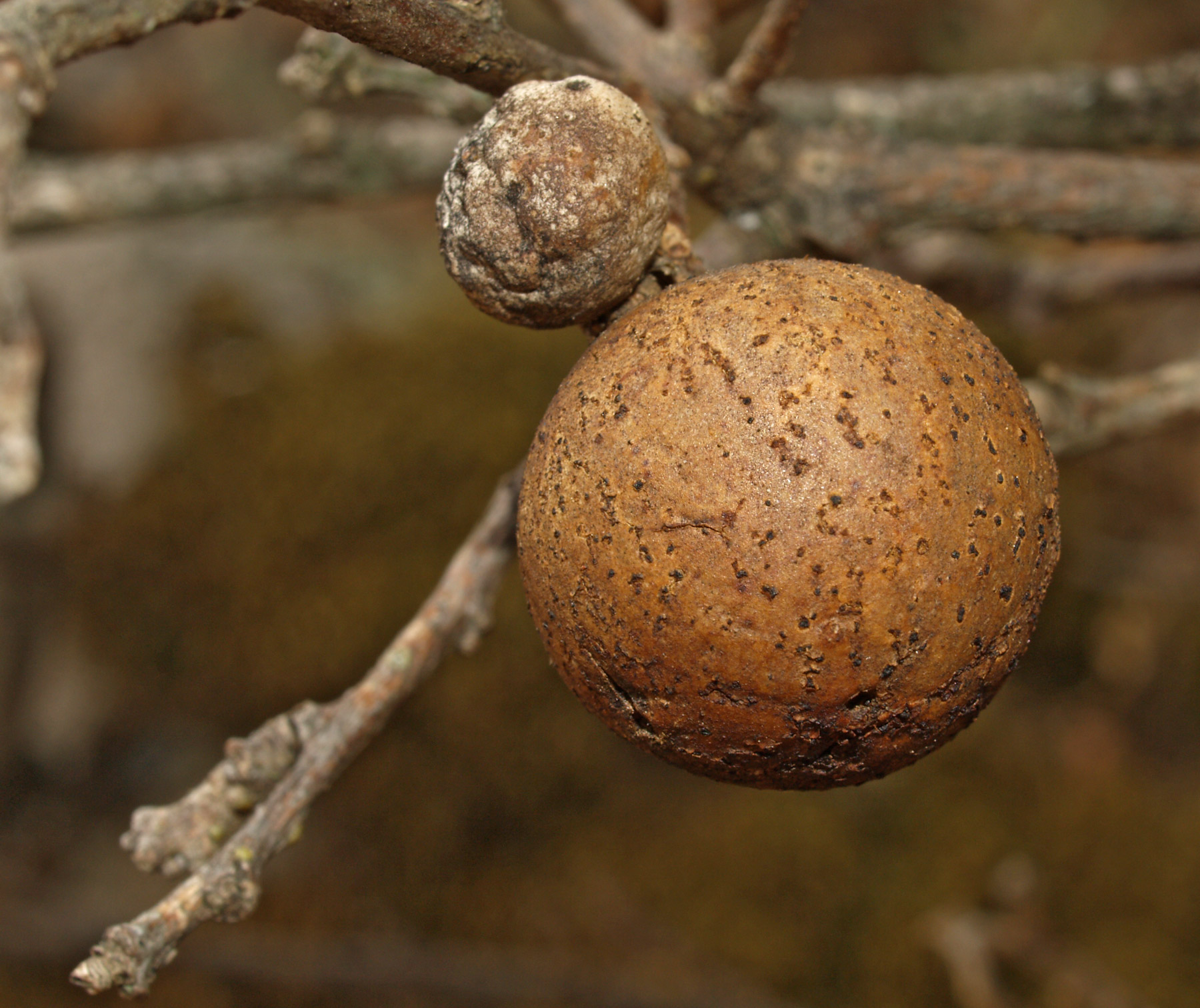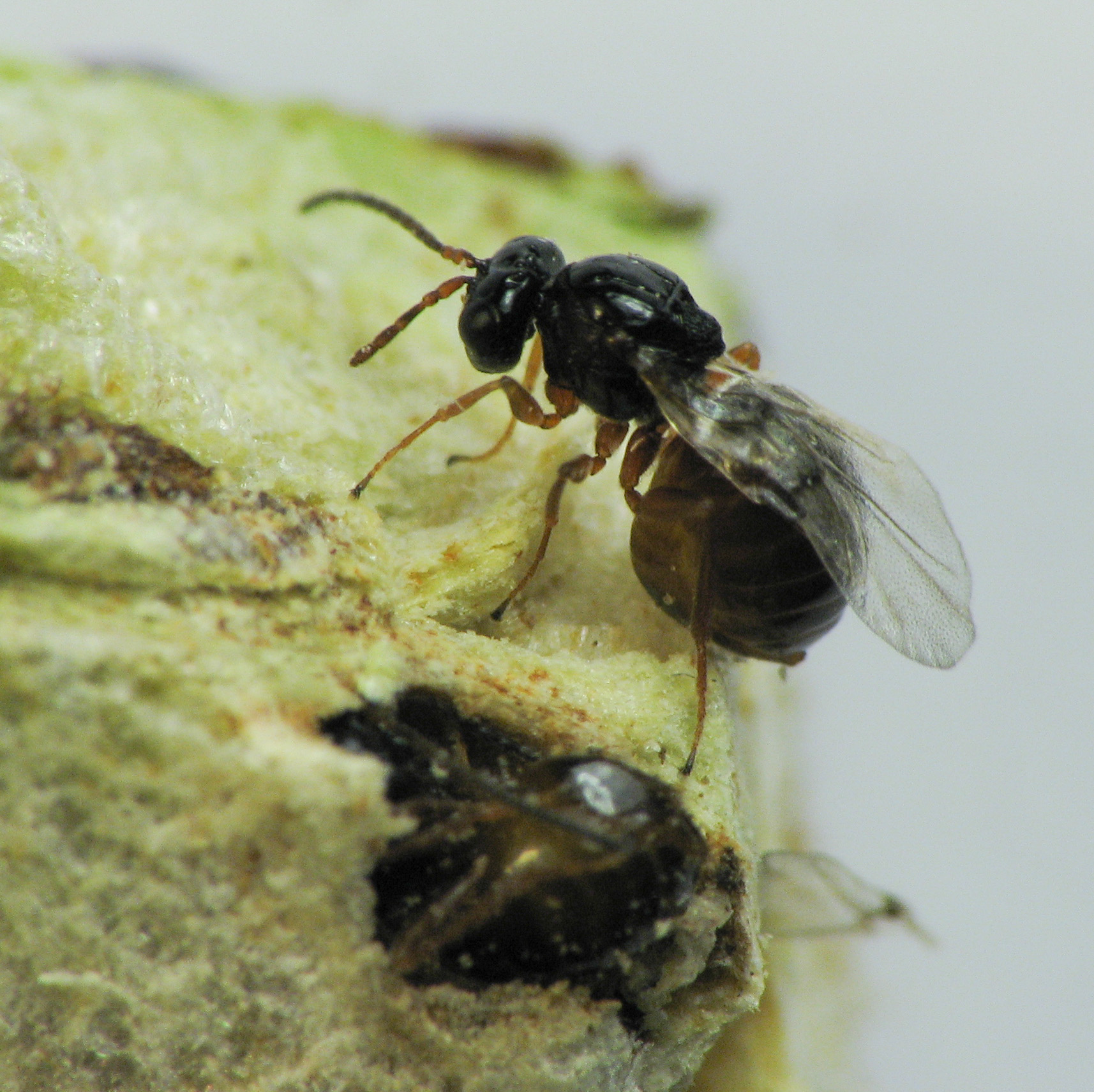|
Feron Parmula
''Feron parmula'', also known as the disc gall wasp, is a species of oak gall wasp in the genus ''Feron.'' It induces galls in a wide selection of oak species, especially white oaks, and including hybrids. The galls are disc-shaped, up to 3 mm in diameter, and pale with red streaking. Adult females emerge in April. The galls induced by ''F. parmula'' superficially resemble the galls of ''Feron gigas ''Feron gigas'', also known as the saucer gall wasp, is a species of gall-forming wasp in the genus '' Feron.'' It induces galls on the leaves of scrub oaks, blue oaks, and Engelmann oaks. The galls produced by its all-female generation, whi ...,'' '' Andricus viscidus'', and newly identified species called the " plate gall wasp" and the " orange-cap gall wasp" by Ronald Russo. Galls induced by this wasp have been documented in Oregon and California on the Pacific coast of North America. References External links ''Andricus parmula'' on gallformers Cynipidae Gall-i ... [...More Info...] [...Related Items...] OR: [Wikipedia] [Google] [Baidu] |
Cynipini
Cynipini is a tribe (biology), tribe of gall wasps. These insects induce galls in plants of the beech and oak family, Fagaceae. They are known commonly as the oak gall wasps.Melika, G., et al. (2013)A new genus of oak gallwasp, ''Cyclocynips'' Melika, Tang & Sinclair (Hymenoptera: Cynipidae: Cynipini), with descriptions of two new species from Taiwan.''Zootaxa'' 3630(3), 534-48. It is the largest cynipid tribe, with about 936Medianero, E. and J. L. Nieves-Aldrey. (2013)''Barucynips panamensis'', a new genus and species of oak gallwasps (Hymenoptera, Cynipidae, Cynipini) from Panama, and description of one new species of ''Coffeikokkos''.''ZooKeys'' (277), 25-46. to 1000 recognized species, most of which are associated with oaks. The tribe is mainly native to the Holarctic. Cynipini wasps can act as ecosystem engineers. Their galls can become hosts of inquilines, and the wasps themselves are hosts to parasitoids. Most of these wasps undergo cyclical parthenogenesis, sometimes repr ... [...More Info...] [...Related Items...] OR: [Wikipedia] [Google] [Baidu] |
Feron (wasp)
''Feron'' is a genus of Cynipini, oak gall wasps in the Nearctic realm, Nearctic. It was established by Alfred Kinsey in 1937, then re-established in 2023. Species The following species are grouped into ''Feron'': * ''Feron albicomus'' (Weld, 1952) * ''Feron amphorus'' (Weld, 1926) *''Feron apiarium'' (Weld, 1944) *''Feron atrimentum'' (Kinsey, 1922) *''Feron bakkeri'' (Lyon, 1984) *''Feron caepula'' (Weld, 1926) *''Feron californicum'' (Beutenmueller, 1911) *''Feron clarkei'' (Bassett, 1890) *''Feron comatum'' (Weld, 1952) *''Feron crystallinum'' (Bassett, 1900) *''Feron cylindratum'' (Kinsey, 1937) *''Feron discale'' (Weld, 1926) *''Feron discularis'' (Weld, 1926) *''Feron dumosae'' (Weld, 1957) *''Feron gigas'' (Kinsey, 1922) *''Feron izabellae'' (Melika, Nicholls & Stone) *''Feron kingi'' (Bassett, 1900) *''Feron parmula'' (Bassett, 1900) *''Feron pattersonae'' (Fullaway, 1911) *''Feron roberti'' (Melika, Nicholls & Stone) *''Feron rucklei'' (Melika, Nicholls & Stone) *'' ... [...More Info...] [...Related Items...] OR: [Wikipedia] [Google] [Baidu] |
Quercus Subg
An oak is a hardwood tree or shrub in the genus ''Quercus'' of the beech family. They have spirally arranged leaves, often with lobed edges, and a nut called an acorn, borne within a cup. The genus is widely distributed in the Northern Hemisphere; it includes some 500 species, both deciduous and evergreen. Fossil oaks date back to the Middle Eocene. Molecular phylogeny shows that the genus is divided into Old World and New World clades, but many oak species hybridise freely, making the genus's history difficult to resolve. Ecologically, oaks are keystone species in habitats from Mediterranean semi-desert to subtropical rainforest. They live in association with many kinds of fungi including truffles. Oaks support more than 950 species of caterpillar, many kinds of gall wasp which form distinctive galls (roundish woody lumps such as the oak apple), and a large number of pests and diseases. Oak leaves and acorns contain enough tannin to be toxic to cattle, but pigs are able to ... [...More Info...] [...Related Items...] OR: [Wikipedia] [Google] [Baidu] |
Princeton University Press
Princeton University Press is an independent publisher with close connections to Princeton University. Its mission is to disseminate scholarship within academia and society at large. The press was founded by Whitney Darrow, with the financial support of Charles Scribner, as a printing press to serve the Princeton community in 1905. Its distinctive building was constructed in 1911 on William Street in Princeton. Its first book was a new 1912 edition of John Witherspoon's ''Lectures on Moral Philosophy.'' History Princeton University Press was founded in 1905 by a recent Princeton graduate, Whitney Darrow, with financial support from another Princetonian, Charles Scribner II. Darrow and Scribner purchased the equipment and assumed the operations of two already existing local publishers, that of the ''Princeton Alumni Weekly'' and the Princeton Press. The new press printed both local newspapers, university documents, '' The Daily Princetonian'', and later added book publishing ... [...More Info...] [...Related Items...] OR: [Wikipedia] [Google] [Baidu] |
Andricus Gigas
''Andricus'' is a genus of oak gall wasps in the family Cynipidae. Life cycle As in all Hymenoptera, sex-determination in species of the genus ''Andricus'' is governed by haplodiploidy: males develop from unfertilized eggs and are haploid, and females develop from fertilized eggs and are diploid. Many species in the genus alternate between an asexual generation and a sexual generation. Species The taxonomy of the genus ''Andricus'' is uncertain, with many of the approximately 375 species considered dubious. The following species are currently recognised in the genus ''Andricus'': * '' Andricus aciculatus'' Beutenmuller, 1909 * '' Andricus ahmeti'' Melika, Mutun & Dinç, 2014 * '' Andricus albipes'' Hartig, 1840 * '' Andricus albobalani'' Weld, 1926 * '' Andricus alniensis'' Folliot, 1964 * '' Andricus amblycerus'' (Giraud, 1859) * '' Andricus amenti'' Giraud, 1859 * '' Andricus analis'' (Fonscolombe, 1832) * '' Andricus anatolicus'' Melika, Mutun & Dinç, 2014 * '' Andr ... [...More Info...] [...Related Items...] OR: [Wikipedia] [Google] [Baidu] |
Andricus Viscidus
''Andricus'' is a genus of oak gall wasps in the family Cynipidae. Life cycle As in all Hymenoptera, sex-determination in species of the genus ''Andricus'' is governed by haplodiploidy: males develop from unfertilized eggs and are haploid, and females develop from fertilized eggs and are diploid. Many species in the genus alternate between an asexual generation and a sexual generation. Species The taxonomy of the genus ''Andricus'' is uncertain, with many of the approximately 375 species considered dubious. The following species are currently recognised in the genus ''Andricus'': * '' Andricus aciculatus'' Beutenmuller, 1909 * '' Andricus ahmeti'' Melika, Mutun & Dinç, 2014 * ''Andricus albipes'' Hartig, 1840 * '' Andricus albobalani'' Weld, 1926 * '' Andricus alniensis'' Folliot, 1964 * '' Andricus amblycerus'' (Giraud, 1859) * ''Andricus amenti'' Giraud, 1859 * ''Andricus analis'' (Fonscolombe, 1832) * ''Andricus anatolicus'' Melika, Mutun & Dinç, 2014 * ''Andricus archi ... [...More Info...] [...Related Items...] OR: [Wikipedia] [Google] [Baidu] |
Plate Gall Wasp
Plate may refer to: Cooking * Plate (dishware), broad, mainly flat vessel commonly used to serve food * Plates, tableware, dishes or dishware used for setting a table, serving food and dining * Plate, the content of such a plate (for example: rice plate) * Plate, to present food, on a plate * Plate, forequarter cut of beef Places * Plate, Germany, municipality in Parchim, Mecklenburg-Vorpommern, Germany * Plate, borough of Lüchow, Lower Saxony, Germany * River Plate (other) * Tourelle de la Plate, lighthouse in France Science and technology Biology and medicine * Plate (anatomy), several meanings * Dental plate, also known as dentures * Dynamic compression plate, metallic plate used in orthopedics to fix bone * Microtiter plate (or microplate or microwell plate), flat plate with multiple "wells" used as small test tubes * Orthopedic plate, internal fixation used in orthopaedic surgery * Petri dish or Petri plate, shallow dish on which biological cultures ma ... [...More Info...] [...Related Items...] OR: [Wikipedia] [Google] [Baidu] |
Ronald A
Ronald is a masculine given name derived from the Old Norse ''Rögnvaldr'', Hanks; Hardcastle; Hodges (2006) p. 234; Hanks; Hodges (2003) § Ronald. or possibly from Old English '' Regenweald''. In some cases ''Ronald'' is an Anglicised form of the Gaelic '' Raghnall'', a name likewise derived from ''Rögnvaldr''. The latter name is composed of the Old Norse elements ''regin'' ("advice", "decision") and ''valdr'' ("ruler"). ''Ronald'' was originally used in England and Scotland, where Scandinavian influences were once substantial, although now the name is common throughout the English-speaking world. A short form of ''Ronald'' is ''Ron''. Pet forms of ''Ronald'' include ''Roni'' and '' Ronnie''. ''Ronalda'' and ''Rhonda'' are feminine forms of ''Ronald''. ''Rhona'', a modern name apparently only dating back to the late nineteenth century, may have originated as a feminine form of ''Ronald''. Hanks; Hardcastle; Hodges (2006) pp. 230, 408; Hanks; Hodges (2003) § Rhona. The names ... [...More Info...] [...Related Items...] OR: [Wikipedia] [Google] [Baidu] |
Cynipidae
Gall wasps, also wikt:gallfly#Usage notes, traditionally called gallflies, are hymenopterans of the family Cynipidae in the wasp superfamily Cynipoidea. Their common name comes from the galls they induce on plants for larval development. About 1,300 species of this generally very small creature () are known worldwide, with about 360 species of 36 different genera in Europe and some 800 species in North America. Features Like all Apocrita, gall wasps have a distinctive body shape, the so-called Petiole (insect anatomy), wasp waist. The first abdominal tergum (the propodeum) is conjoined with the Thorax (insect anatomy), thorax, while the second abdominal segment forms a sort of shaft, the Petiole (insect anatomy), petiole. The petiole connects with the gaster (insect anatomy), gaster, which is the functional abdomen in apocritan wasps, starting with the third abdominal segment proper. Together, the petiole and the gaster form the metasoma, while the thorax and the propodeum mak ... [...More Info...] [...Related Items...] OR: [Wikipedia] [Google] [Baidu] |
Oak Galls
An oak apple or oak gall is a large, round, vaguely apple-like gall commonly found on many species of oak. Oak apples range in size from in diameter and are caused by chemicals injected by the larva of certain kinds of gall wasp in the family Cynipidae. Formation The adult female wasp lays single eggs in developing leaf buds. The wasp larvae feed on the gall Tissue (biology), tissue resulting from their secretions, which modify the oak bud into the gall, a structure that protects the developing larvae until they undergo metamorphosis into adults. Some common oak-apple-forming species are the ''Biorhiza pallida'' gall wasp in Europe, ''Amphibolips confluenta'' in eastern North America, and ''Atrusca bella'' in western North America. Oak apples may be brownish, yellowish, greenish, pinkish, or reddish. Other galls Considerable confusion exists in the general literature between the oak apple and the Andricus kollari, oak marble gall. The oak marble is frequently called the o ... [...More Info...] [...Related Items...] OR: [Wikipedia] [Google] [Baidu] |



